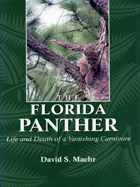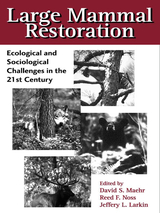
When the first field study of the Florida panther took place in 1973, so little was known about the animal that many scientists believed it was already extinct. During more extensive research conducted from 1981 to 1986, panthers were proven to exist, but the handful of senile, anemic, and parasite-infested specimens that were captured indicated a grim future. During those early years a remarkably enduring image of the panther was born, and despite voluminous data gathered over the next decade that showed the panther to be healthy, long-lived, and reproducing, that earlier image has yet to be dispelled.
For nine years, biologist David S. Maehr served as project leader of the Florida Panther Study Project, helping to gather much of the later, surprisingly positive data. In The Florida Panther, he presents the first detailed portrait of the animal -- its biology, natural history, and current status -- and a realistic assessment of its prospects for survival.
Maehr also provides an intriguing look at the life and work of a field biologist: how captures are made, the intricacies of radio-telemetry tracking, the roles of various team members. He describes the devastating intrusion of politics into scientific work, as he discusses the widespread problems caused by the failure of remote and ill-informed managers to provide needed support and to communicate effectively to the public the goals and accomplishments of the scientists. He examines controversial efforts to establish a captive breeding program and to manipulate the Florida panther's genetic stock with the introduction of relatives from west Texas.
Protection of high-quality habitat, much of it in the hands of private landowners, is the key to the long-term survival of the Florida panther. Unless agency decisionmakers and the public are aware of the panther's true situation, little can be done to save it. This book will play a vital role in correcting widespread misconceptions about the panther's current condition and threats to its survival.

Evidence is mounting that top carnivores and other large mammals play a pivotal role in regulating ecosystem health and function, yet those are the species that are most likely to have been eliminated by past human activities. In recent decades, numerous efforts have been undertaken to return some of the species that were previously extirpated on local or regional scales.
Large Mammal Restoration brings together for the first time detailed case studies of those efforts, from restoring elk in Appalachia to returning bison herds to the Great Plains to the much-publicized effort to bring back the gray wolf to Yellowstone National Park. Together these case studies offer important lessons and new ways of thinking for wildlife managers and conservation biologists involved with restoration programs. Sections examine:
- approaches to determining the feasibility of a restoration program
- critical hands-on aspects of restoring large mammals
- obtaining public input into the process and gaining community support for programs
- the potential of some species to return without direct human intervention, and what can be done to facilitate that natural colonization
Large Mammal Restoration brings together in a single volume essential information on the lessons learned from previous efforts, providing an invaluable resource for researchers and students of conservation biology and wildlife management as well as for policymakers, restoration advocates, and others involved with the planning or execution of a restoration program.
READERS
Browse our collection.
PUBLISHERS
See BiblioVault's publisher services.
STUDENT SERVICES
Files for college accessibility offices.
UChicago Accessibility Resources
home | accessibility | search | about | contact us
BiblioVault ® 2001 - 2024
The University of Chicago Press









